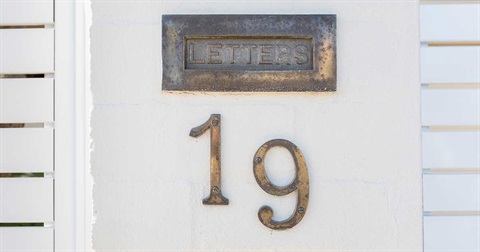Addressing properties

Property owners must display the house number on their building or fence fronting the street (Local Government Act 1993).
Australian standard of rural and urban addressing
Council is the street addressing authority or agency responsible for assigning addresses.
When assigning addresses, Council complies with the Australian Standard of Rural and Urban addressing – AS/NZS 4819:2011 and the NSW Geographical Names Board’s NSW Address Policy and User Manual.
Once an address has been allocated to a property, Council forwards the information to NSW Spatial Services who maintain a central database. This database is used by NSW Land Registry Services, emergency services, telecommunication authorities, and other service providers. The information is also provided to Australia Post.
If you require an address, or need an address changed, please contact Council’s Property Officer on 02 6670 2400 or email propertyofficer@tweed.nsw.gov.au.
Download the Addressing – rural and urban policy(PDF, 202KB)
Kerbside numbering
The painting of house numbers on kerbs is optional in the Tweed. If you decide to number your kerbside, you must meet the following requirements.
- Before occupation of the building the property street number is to be clearly identified on the site by way of painted numbering on the street gutter within one metre of the access point to the property.
- The street number is to be on a white reflective background professionally painted in black numbers 100 mm (10 cm) high. On rural properties or where street guttering is not provided the street number is to be readily identifiable on or near the front entrance to the site.
- For multiple allotments having single access points, or other difficult to identify properties, specific arrangements should first be made with Council and emergency services before street number identification is provided.
- The above requirement is to assist in property identification by emergency services and other service providers. Any variations to the above are to be approved by Council prior to carrying out the work.
- In all instances, stencils used must be engineered precisely to totally preclude over-spray and under-run.
- Numbers are to be painted on the kerbside vertical face, or the front sloping face of roll-on type kerbs.
- Numbers must be on the kerb of the street that the number refers to only.
Information for organisations contracted to paint numbers
- The intention of your organisation should be explained to the residents and/or owners of the property, when the work is being canvassed.
- Your organisation will need to exercise due care to ensure that the correct house numbers are used for each property, and in this regard, it is suggested that you confirm with Council, prior to undertaking work.
- It should be noted that numbering on kerbs in no way reduces the obligation of the property owner, to display the correct house number on their building or fence fronting the street, pursuant to section 124 paragraph 8 of the Local Government Act 1993.
- Council is not, under any circumstance, responsible for the maintenance or repair of painted numbers.
- It should be noted that Council approval does not give your organisation exclusive rights for the provision of this service within the Tweed Shire.
- You should explain to residents that the painting of house numbers on kerbs is not compulsory in the Tweed.